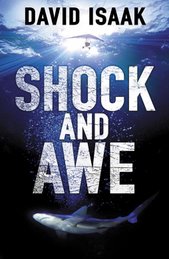Leslie Schwartz, a fine novelist I know, once advised a class of writing students, "Be fearless about cutting, even if the sections you cut are some of your best writing. You can always set them aside in files of their own and use them for another project some day."
Then, with a sly smile, she added, "Of course, you'll probably never use them--but telling yourself you might makes the cutting less painful."
I have cut passages. And in the editing of Shock and Awe, at Will's behest I added back a section I had cut before I submitted it. (He noticed something was missing, and he was right).
But, as Leslie suggests, I've never cut anything and then used it in another project. I keep hoping this might happen, but it never seems to come up; my books don't seem to be written so that a passage from one might be dropped into another with only minor adjustments. (Indeed, not even with major adjustments.) I was nosing through my computer folder of fragments the other day, and I still don't see any use for them.
My most interesting fragments are those that were "planned cuts." When I'm trying to get a major viewpoint character on paper, I often write a scene that I have no intention of including in the book--one that in fact would be a distraction from the story. These are usually personal scenes from some other time in the character's life; an interaction that gives me a sense of how the character would behave in a situation that never is touched on in the story.
I tell myself this adds to the submerged-iceberg of what the reader never knows, yet somehow senses. The exercise gives me a weird sort of confidence I have the 'inside story' on the character, that I have some voyeuristic insight denied to others who have not read that extra scene.
When you think about it, my whole theory is a little cracked. I mean, I ought to know more about my characters than anyone else does, because, at least in principle, I invented them. And I shouldn't be able to get any extra knowledge by spying on them in private, as I'm making up those bits, too. Yet an extra, undisclosed scene makes me feel closer to a character than if I published it, makes me feel as if we share a secret bond.
Oh, well. No one ever argued it's sensible to sit alone for hours making up stories about nonexistent people in the first place.
PS. My sister Amber sent me an e-mail informing me that inventing a scene not intended to be presented in the work is one of the techniques of Method Acting.
I'm apparently a Method Writer. Who knew?
Monday, September 15, 2008
Subscribe to:
Post Comments (Atom)



9 comments:
Ever thought of reworking those scenes as short stories? I've been thinking of looking at my cuttees with that in mind, but it scares me a bit, don't ask me why.
I've cut 40,000 words from the latest mishap, and decided they make a very nice novella with the names changes and a bit of character development thrown in. I've called it, 'The Astounding Tale of the Red Sock Gang.' I think it really works. Very pacey, and utterly strange. So you see, there's hope for offcuts everywhere.
I cut a whole sub-plot from The Hoard of Mhorrer due to plot-economics (i.e. it was a little distracting from the main plot). Now while this subplot wasn't necessary for book 2, it is necessary for book 3. Hence why book 3 is now book 4, and book 3 is the sub-plot but with loads more room to expand characters and situations.
Not sure what Pan Mac will make of it, but it might turn out to be a flash of genius by expanding this subplot to a book of it's own...
Or it might be pants.
Hi, Janet--
In principle, that's a cool idea. But for me, trying to write a short story is just a way of starting a novel without intending to do so.
I like short stories. But I don't have the keen sense of boundaries needed to write them.
Hi, Aliya--
Are those the famous Albanians in Red Bootees? (And why do I have the urge to sing that to the tune of "Nights in White Satin"?)
If so, I'm thrilled they've been saved. They sounded like a good idea to me.
Hi, Matt--
That sounds like seredipity indeed. It's also the best argument I've ever heard for a series of world-building novels--anything substantive you can come up with is bound to fit somewhere sooner or later, even if it doesn't fit the shape of a particular book.
That does it. I'm changing genres.
I have copious offcut files, but have never reused any of the material. The present WIP is likely to set a new record for discarded material. But it's been unusually valuable in developing character, so I don't begrudge the time...much.
I rarely re-use specific scenes that I cut, but I often save the ideas I discovered in those scenes. I don't usually mind cutting scenes. (Is that odd? It sounds odd.) Once, though, I had to trash a prologue where the future-seeing main character ate his birthday cake while an atomic bomb hit NYC.
I do tend to write lots of stuff that I don't plan using in the real novel. I find it very beneficial to write a few key scenes from the antagonists point-of-view.
-C.A.
The first drafts of my books are always twice as long as they need to be. I must be a method writer too.
Post a Comment